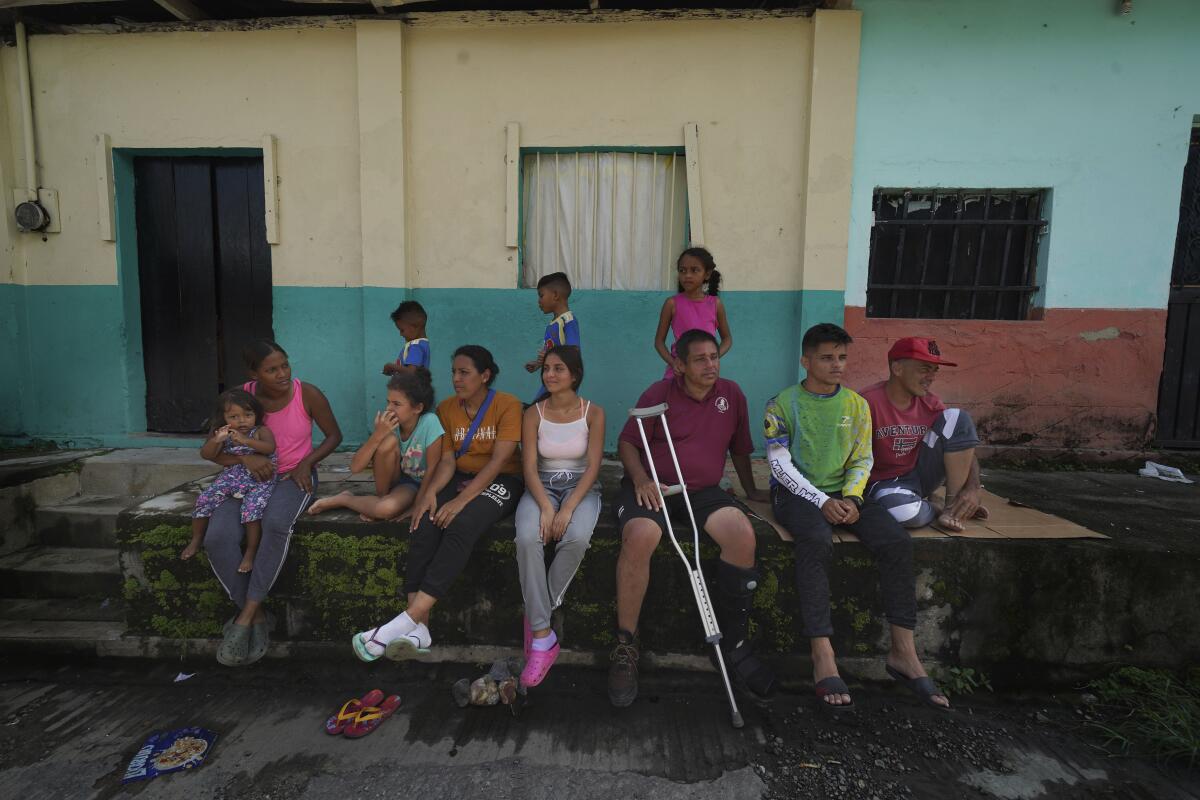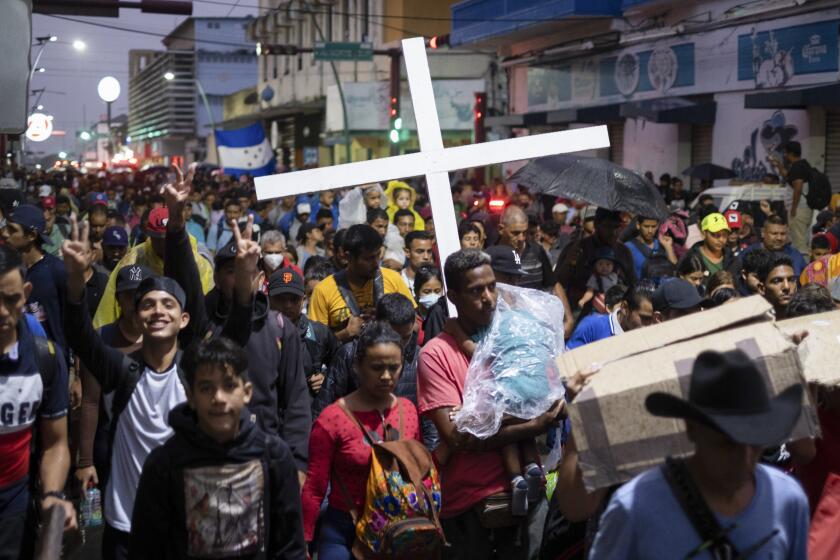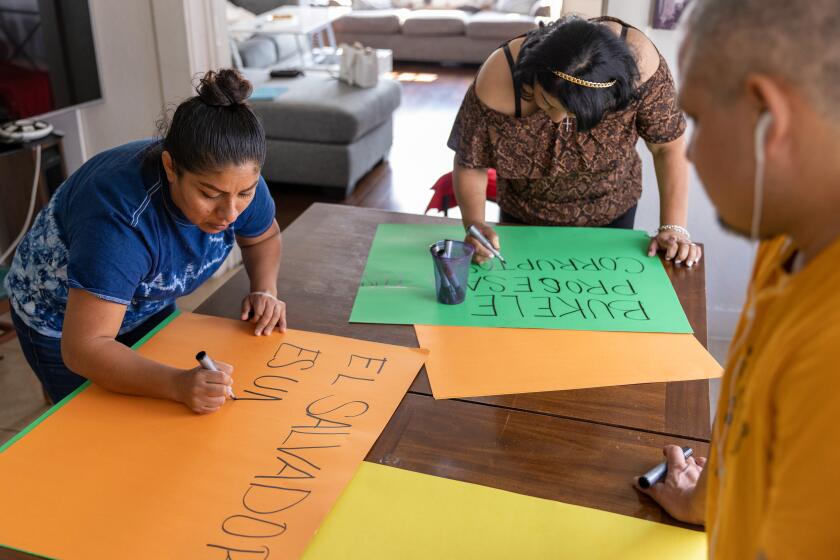Venezuelans a big presence in U.S.-bound caravan after visa requirement

HUIXTLA, Mexico â After walking for two days along rural highways in southern Mexico with several thousand other migrants, Venezuelan Wilber Pires spent what was supposed to be a day of rest for the caravan asking for help to buy medicine for his daughter.
Two-year-old Valesca Pires was hospitalized in Huixtla overnight with a high fever. Other children in the extended family of 18 were sick as well and covered with mosquito bites. Under the roof of a covered court where migrants slept side by side on sheets spread over concrete, adults tended to battered feet after walking some 25 miles since departing Tapachula, Mexico, on Monday.
âIf itâs hard for an adult, imagine it for her,â Pires said of his daughter.
Venezuelans make up a large proportion of this caravan, the biggest of the year, in contrast to previous ones. A factor appears to be a policy change implemented by Mexico in January requiring Venezuelans to acquire a visa to enter the country.
Before that change, Venezuelans had flown to Mexico City or Cancun as tourists and then made their way comfortably to the border. Many made it from home to the U.S. border in as little as four days.
Encounters with Venezuelans at the southwestern U.S. border plunged from 22,779 in January to 3,073 in February, according to Customs and Border Protection. In April, the most recent month for which data were available, there were 4,103 encounters.
But the flow of Venezuelan migrants has continued. Since January, more than half of the 34,000 migrants who crossed the treacherous Darien Gap between Colombia and Panama were Venezuelans, according to Panamaâs National Migration Service.
Several thousand migrants have set out walking in the rain in southern Mexico, tired of waiting to normalize their status in a region with little work.
The visa requirement drove the flow of Venezuelans into the shadows. Those traveling in the caravan are just the visible sign of who is traveling through Mexico out of public view. Many other Venezuelans have probably turned to smugglers.
It was in January, the month Mexico imposed the visa requirement, when Pires and extended family members spread across two cities in Venezuela began a online group chat that would eventually lead to a decision to leave their country en masse.
Wildre Pires Ălvarez, a cousin traveling with his wife and two children, said it took three months of discussion to decide to leave.
âI was earning $3 to $6 a week,â Pires Ălvarez said. âBut if you ask me how far that reached: a kilo of rice, a kilo of pasta, a kilo of beans and there went my $6.â Family members complained of frequent electrical blackouts, scarcity and a lack of basic services.
âThe goal is the United States,â he said. âThe dream is to work and be able to support more family members who stayed in Venezuela.â
The extended family of 18, including eight children, traveled from Venezuela to Mexico in 15 days.
On the first day of the three it took to navigate the thick jungle of the Darien Gap, Piresâ cousin Eymar HernĂĄndez passed out.
Flor de los Ăngeles, HernĂĄndezâs 11-year-old daughter, cried at the memory of her unconscious father.
Immigrants from El Salvador, Guatemala, Nicaragua and Mexico are going to demonstrate when leaders from across the hemisphere gather in Los Angeles next week.
âHe had a problem, and they had to help him, give him fluids, air,â she said. âHe was really bad in the jungle, and that was really hard for me because I was scared about what would happen.â
The family requested asylum in Tapachula and were given appointments in July to begin the process. They said they did not have enough money to be able to wait that long in a city where work and affordable housing have been scarce.
Jenny Villamizar, HernĂĄndezâs wife, said the constant uncertainty, the overwhelming fear that they will not be able to continue, has been awful.
âThis is terrible anguish not knowing what weâll be able to achieve, what weâre going to be able to do,â Villamizar said.
Negotiations among the migrants, their advocates and the Mexican government continued Wednesday. Recently, the government has dissolved other caravans by offering to move migrants to other cities where they could legalize their status more quickly.
Finding consensus on managing migration flows in the region was a top priority for representatives meeting this week at the Summit of the Americas in Los Angeles.
On Friday, the U.S. and 19 other nations signed the Los Angeles Declaration, an agreement to expand legal pathways for migrants and provide funding for the countries hosting them.
JesĂşs Enrique GonzĂĄlez, a Venezuelan migrant traveling with 10 relatives, including his seven children, said the money he made as a butcher at home was no longer enough to make ends meet with constantly rising prices.
So they left and have been traveling for two months.
Since Panama, GonzĂĄlezâs children have been crucial in helping their father continue. He fell while crossing the Darien Gap and broke his left foot, an injury that requires surgery, which he has been unable to attain.
The 53-year-old man is alternating between crutches and a wheelchair pushed by relatives and friends as the family continues north. They were the last migrants to reach Huixtla on Tuesday.
âWe fought until the end to stay in our country because everyone loves their country,â GonzĂĄlez said. âBut seeing how everything was a struggle and we never reached a goal, we decided to leave.â
More to Read
Sign up for Essential California
The most important California stories and recommendations in your inbox every morning.
You may occasionally receive promotional content from the Los Angeles Times.












